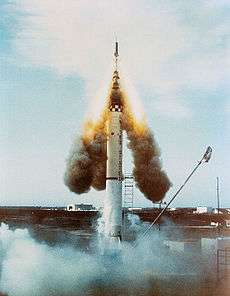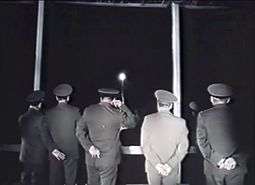Launch escape system

A launch escape system is a crew safety system connected to a space capsule, used to quickly separate the capsule from its launch vehicle rocket in case of a launch abort emergency, such as an impending explosion. Such systems are usually of two types:
- A solid-fueled rocket, mounted above the capsule on a tower, which delivers a relatively large thrust for a brief period of time to send the capsule a safe distance away from the launch vehicle, at which point the capsule's parachute recovery system can be used for a safe landing on ground or water. The tower and rocket are jettisoned from the space vehicle in a normal flight at the point where it is either no longer needed, or cannot be effectively used to abort the flight. These have been used on the Mercury, Apollo, and Soyuz capsules.
- The crew are seated in ejection seats as used in military aircraft; each crewmember returns to Earth with an individual parachute. Such systems are effective in a limited range of altitudes and speeds. These have been used on the Vostok and Gemini capsules.
The system is typically controlled by a combination of automatic rocket failure detection, and a manual backup for the crew commander's use.
Escape systems have not proven to be practical for more complex spacecraft designs such as the Space Shuttle, mainly because most crew members cannot be seated next to escape hatches.
History

The idea of using a rocket to remove the capsule from a space vehicle was developed by Maxime Faget in 1958.[1] The system, using the tower on the top of the space capsule to house rockets, was first used on a test of the Project Mercury capsule in March 1959. Historically, LESes were used on American Mercury and Apollo spacecraft. Both designs used a solid-fuel rocket motor. The Mercury LES was built by the Grand Central Rocket Company in Redlands, California (which later became the Lockheed Propulsion Company). Apollo used a design that had many similarities to the Mercury system. Launch Escape Systems continue to be used on the Russian Soyuz and Chinese Shenzhou programme spacecraft. The SpaceX-designed Dragon spacecraft uses a liquid fueled launch abort system integrated to the capsule to minimize spacecraft costs.
The LES may be used while the launch vehicle is still on the launch pad, or during its ascent.
Related systems
The Soviet Vostok and American Gemini spacecraft both made use of ejection seats. The European Space Agency's Hermes and the Soviet Buran space planes would also have made use of them if they had ever flown with crews. As shown by Soyuz T-10a, an LES must be able to carry a crew compartment from the launch pad to a height sufficient for its parachutes to open. Consequently, they must make use of large, powerful (and heavy) solid rockets. The Soyuz launch escape system is called CAC or SAS, from the Russian/transliterated Russian Система Аварийного Спасения or Sistema Avariynogo Spaseniya, meaning emergency rescue system.[2]
The Space Shuttle was fitted with ejection seats for the two pilots in the initial "shakedown" flights, but these were removed once the vehicle was deemed operational and carried additional crew members, which could not be provided with escape hatches. Following the Challenger disaster, all surviving orbiters were fitted to allow for crew evacuation through the main ingress/egress hatch, only when the Shuttle was in a controlled glide, as the crew would have had to reach the exit from their seats and jump out.
.jpg)
The Orion Multi-Purpose Crew Vehicle being developed to follow the shuttle program will use a Mercury and Apollo-style escape rocket system, while an alternative system, called the Max Launch Abort System (MLAS),[3] has been floated to use existing solid-rocket motors integrated into the bullet-shaped protective launch shroud.
Under NASA's Commercial Crew Development (CCDev) program Blue Origin has been awarded $3.7 million for development an innovative 'pusher' LAS.[4]
Also under NASA's CCDev program, SpaceX was awarded $75 million for the development of their own version of a "pusher" LAS.[5] Its Dragon V2 spacecraft will use its SuperDraco engines during a launch abort scenario. The concept was first tested in a Pad Abort test conducted at SLC-40, Cape Canaveral Air Force Station, on May 6, 2015.[6] SpaceX will next test the system during asscent of the Falcon 9 rocket in from Kennedy Space Center Launch Complex 39 where it plans to launch crews to the International Space Station.[7]
Orbital Sciences Corporation intends to sell the LAS it was building for the Orion spacecraft to future commercial crew vehicle providers in the wake of cancellation of the Constellation project.[8]
Usage
The first fully operational test flight of an LES was Apollo mission A-004 on January 20, 1966. The mission used a Little Joe II booster, carrying an early version of the Apollo Command/Service Module.

Only one emergency use of an LES has occurred. This occurred during the attempt to launch Soyuz T-10-1 on September 26, 1983. The rocket caught fire, just before launch, and the LES carried the crew capsule clear, seconds before the rocket exploded. The crew were subjected to an acceleration of 14 to 17 g (140 to 170 m/s2) for five seconds. Reportedly, the capsule reached an altitude of 2,000 meters (6,500 ft) and landed 4 kilometers (2.5 mi) from the launch pad. The Soyuz LES system also has grid fins mounted on the payload fairing that deploy to stabilize the craft.
A previous launch accident occurred during the flight of Soyuz 18a on April 5, 1975. In this case, the incident took place at high altitude, after the LES of the Soyuz had been discarded.[9] The spacecraft automatically separated from the malfunctioning rocket and completed a successful re-entry.
See also
- Apollo spacecraft
- Apollo abort modes
- Pad Abort Test-1 - Launch Escape System (LES) abort test from launch pad with Apollo Boilerplate BP-6.
- Pad Abort Test-2 - LES pad abort test of near Block-I CM with Apollo Boilerplate B-23A.
References
![]() This article incorporates public domain material from websites or documents of the National Aeronautics and Space Administration.
This article incorporates public domain material from websites or documents of the National Aeronautics and Space Administration.
- ↑ "astronautix Escape Tower".
- ↑ http://suzymchale.com/ruspace/soyescape.html
- ↑ NASA Spaceflight: Orion MLAS
- ↑ Jeff Foust. "Blue Origin proposes orbital vehicle".
- ↑ Frank Morring, Jr. "NASA Provides Seed Money For CCDev-2".
- ↑ http://www.spacex.com/news/2015/05/06/crew-dragon-completes-pad-abort-test
- ↑ "SpaceX moves launch of Dragon abort test to KSC". Local 6.
- ↑ Stephen Clark. "Orbital sees bright future for Orion launch abort system".
- ↑ Shayler, David (2000). Disasters and Accidents in Manned Space Flight. Springer Praxis. p. 157. ISBN 1-85233-225-5.
External links
| Wikimedia Commons has media related to Launch escape systems. |
- Launch Escape Subsystem - Detailed description of the Apollo launch escape system at Apollosaturn.com
- Soyuz T-10-1
- NASA Orion Pad Abort 1 Test Flight Photos
- NASA Pad Abort 1 Flight Test Video Highlights
| |||||||||||||||||||||||||||||||||
